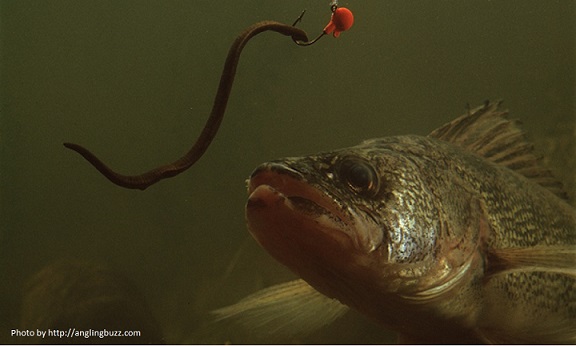This is a summary of a discussion on walleye fishing provided by Matt Zazula at our April 2016 ODFGA monthly meeting.

There are 3 basic techniques and seasons to Walleye fishing.
Walleye usually feed in the bottom 1 ft of the lake, just off the bottom. In the spring after the spawn they are more lethargic and do not tend to chase baits. Using a jig at this time of year tends to be the best approach. Jigs differ in shapes, weights colour and function. If your jig is not producing change it up after 10 to 15 minutes. Change size, weight and colour as well as style of jigs. Some round heads tend to drop quicker to the bottom rather than fluttering down like the more flat jigs. Some jigs have rattles while others have a plastic shield to cause them to react differently. buck tail jigs work well in murky water and attract by producing a small vibration as well as being more visible. Matt tends to hold his jigs 2 to 6 inches off bottom and every once in a while drop the jig the bottom to cause a noise and try to imitate a feeding fish or other prey. He noted that walleye tend to hit when a jig is dropping so always keep control of your line.
Matt's favorite walleye lure colors are whatever the fish are biting on but notes that orange, yellow, and two tone green/black jigs tend to work well. The key is to experiment. You can jig using a minnow or leach with a minnow you hook it under the jaw with the hook protruding out the mouth so the minnow looks like it is feeding on the jig. If you are on a sandy bottom you might try casting lifting your rod tip and then let the jig settle back down working the jig towards you. This is not possible in weed beds due to snagging up. In weed beds jig horizontally or try a weedless jig.
A Lindy rig utilizes a sliding weight about 4 to 6 ft in front of your floating bait. Lindy Rigs are used when travelling less than 0.5 mph while trolling. For slow trolling using worms, leaches or minnows. Make sure your line behind the weight is straightened out with not a lot of flash as this will tend to scare the fish. He recommends leaving your bail open to allow the fish to take to bait once you feel the hit and set the hook after 3 to 4 seconds. A lindy rig set up with air injected worms also works well for trout. Remember to experiment and try different things with different fish species. Bottom Bouncers are trolled at 1 to 1.2 mph. Use a medium weight rod, say about 7 to 8 ft in length.
Use a heavier line, perhaps a braided line attached to the bottom bouncer with a mono filament line to your bait. Do not use swivels or anything else close to your bait as this will not look natural. A reel with a line counter allows you a more consistent approach as you troll. You can use a bottom bouncer from mid-June through the summer as the fish become more aggressive. This approach will also help you locate fish if you are unsure where they are. You need to feel the bottom on your wire. Use any type of lure you prefer behind a bottom bouncer. Worm harnesses work well. Red colour hooks also help as they signal a wounded fish or prey.
In early spring fish the water that is warmer in north bays or where the wind is blowing bait fish. Look for water warmer than 59 to 60 degrees using jigs.
In the summer as the surface water reaches 68 degrees use bottom bouncers. The fish are more aggressive in the summer. Experiment with spin and glows lure and learn to make up your own adding or subtracting beads. Use vibrations and different colors as the water warms up. If you want to invest your money wisely gather a variety of jigs in colour size and shape to fish for walleye, perch and trout. Remember walleye fishing is low and slow in the spring you will find fish in 12 ft of water and later in 16 to 22 feet. Remember ripples on the surface breaks the light allowing the shy walleye to come out. AM or PM fishing in low light conditions are your best options.
In September you can catch walleye trolling a rattling plug behind a 3-way swivel with a weight attached with 1 ft of line. Have your plug 18 inches to 36 inches behind the swivel so the weight is hitting the bottom.
Thanks for the great discussion on walleye fishing Matt, and thanks Dustin for keeping good notes!